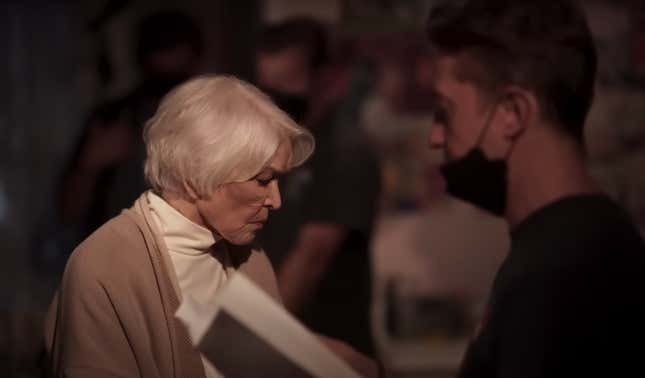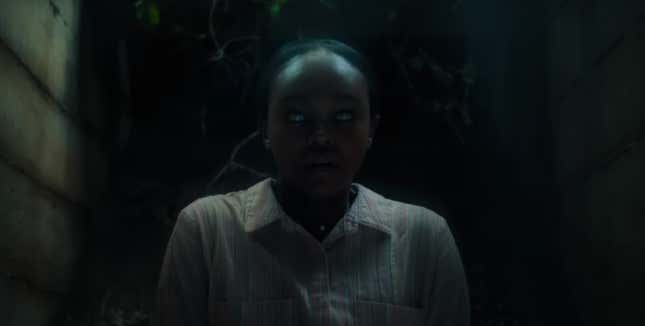After tackling the Halloween universe, director David Gordon Green set his sights on re-imagining The Exorcist for a new generation with The Exorcist: Believer.
io9 sat down with Green to discuss the film he and collaborator Danny McBride (2018 Halloween franchise) co-created, with the filmmaker taking up the reins for a planned three-picture Exorcist series for Universal. In the first film, Believer, we meet Victor Fielding (Leslie Odom Jr.), a widower raising his teen daughter Angela (Lidya Jewett). After she gets lost in the woods with her friend Katherine (Olivia Marcum), Victor and Katherine’s parents (Jennifer Nettles and Norbert Leo Butz) endure the unimaginable when their children return possessed by a familiar demonic force. Together they call upon religious figures and bring in The Exorcist’s Chris MacNeil (Ellen Burstyn) for soul-saving help.
Advertisement
Sabina Graves, io9: Congratulations on the film. To start, I want to take it back. Let’s talk about your first experience of the original Exorcist movie. How old were you and did that first viewing affect you like it has so many? I for sure was traumatized.
Green: I was 14 years old and I was at a public library. My parents were very strict growing up and they didn’t like me watching naughty movies, but I really wanted to see [The Exorcist]. I’d had a bad experience seeing the first Halloween—I had been kind of traumatized by that movie and I wanted to go even deeper into whatever that allure was [when tackling Halloween (2018)]. They had a VHS copy [of The Exorcist at] the public library, so I sat in a cubicle with headphones on and would watch it. I probably watched it in 20 or 30 minute chunks. I know I didn’t watch it all at once, so I watched it in pieces over a number of days.
Advertisement
Advertisement
I was a student at a Jesuit school for that year, and so it kind of all fed into the questions I was asking as a young, curious movie lover and skeptic about the world and how it operates and what’s out there. That all fit into a machine that really, really triggered something in me. I had seen many horror movies, but this felt almost like a documentary. It felt really authentic. And I think, you know, knowing more now about the process and how [director William] Friedkin approached that film, it really was, “If this was really going to happen, how would it play out?” So bringing a clinical authenticity to that, I thought, was important. We took that that idea and translated it into our movie where priests play priests—the Haitian priests in the beginning are the Haitian priests—and [actual] doctors are doing examination of the girls. Those are all medical professionals, the paramedics that show up at the end—those are all EMTs. So it’s really fun for me to kind of try to bring some of that authenticity inspired by Friedkin’s approach.
io9: What were the conversations like with story co-creater Danny McBride when you were spitballing this concept? And going back to your experience as a 14-year-old—did you bring those questions back up in this sort of like arena of how you’re going to tackle The Exorcist: Believer?
Green: I remember sitting in my office with Danny and—so, it’s funny because upstairs we’ve got a writer’s room for Righteous Gemstones. Everybody’s laughing their ass off and we’re downstairs in the editing room talking about if this is going to be something we really want to sink our teeth into. We live in South Carolina, and it’s a bit of a different speed of of everything, from movies to religion. The perspective of cultures is a little different, too. I’ve lived in the South all my life, and I thought the idea of bringing a Baptist perspective, an atheist perspective, a root work perspective—which is a lot more common in my neighborhood. Danny and I got really excited about this interdenominational perspective that we could add to distinguish it from so many of the other exorcism movies out there.
io9: For sure. I jokingly called them Religion Avengers.
Green: Yeah, exactly. I believe me—there was a few of those conversations in production too. Yeah, line them up.
Advertisement
io9: At the end of the last season of The Righteous Gemstones we saw apocalyptic stuff happening. Was that happening at the same time with you really conceptualizing this? Because it kind of tangentially goes hand in hand.
Green: There is an overlap. What we try to do in both of these [stories] that deal with with religion is make sure that we’re bringing it in a conversational way, so that regardless of what your faith is, if you’re watching our form of entertainment, you’re not offended by our perspective. We’re trying to bring platforms of conversation, trying to make it respectful of all denominations. And with Exorcist, we got to enhance that and make that the front lines of our themes.
Advertisement

io9: Yeah, that’s incredible. What was it like working with [The Exorcist star] Ellen Burstyn? I’m really intrigued by the idea of bringing back an actor from the original film and planting them in this new story.
Advertisement
Green: It’s so funny, I had that very similar conversation with Jamie Lee Curtis when we were trying to convince a skeptic to [re-join] the Halloween franchise. How do we approach Ellen and make it something that’s an opportunity for her to ask questions? What would Chris MacNeil have been like for 50 years after the events in Georgetown? She wakes up the next day and she’s processing something. The what-ifs really inspired us to get to work and collaborate with her, and create something that felt relatable to Ellen and her extraordinary journey over the last 50 years. I tried to find parallels that Chris MacNeil could have had that felt relatable to bring an authenticity to that character.
io9: Yes, and I love the newcomers. Leslie Odom Jr. is incredible. And his relationship with Angela and even the other parents with Katherine—you really feel for these families as their children are going through this harrowing experience. What was it like to create this ensemble and family energy, which is such a core to the thematics of the film, but then also tackle what makes The Exorcist terrifying, when these demons take complete control over these child characters?
Advertisement
Green: Working with Leslie Odom, Jr.—he’s always trying to perfect the truth. He’s always trying to find what would the character really do and say. Bringing those kind of opportunities helps all of us on our discovery of truth and trying to make a movie that feels honest and genuine. His character for the first part of the film is kind of an island and isolated and he has lost his faith. And so [we’re] trying to bring that character to life. At the same time, we have another family that has a community, has a congregation in the church that they attend. [Katherine’s parents] Tony and Miranda have each other. And then as the conflict of these two girls brings these families together, brings that community together. That’s when that unity, that community energy starts to become our powerhouse and be real. That’s when we’ve really got a shot at what we’re put here to do when we work together.

Advertisement
io9: Just to touch a bit on the horror elements with the projectile fluids and stuff… what was it like technologically raising the bar with that in this film from what we’ve seen previously—you know, the fun stuff?
Green: I try not to get too comparative to the original film or the movies that have come between because it’s impossible once you start holding yourself up to the standards of others. We just wanted to personally invest in something that we thought was truthful to the story. So if you’re trying to engineer scares, but you don’t have the drama to to give it substance, it’s not going to go anywhere. And you can have a fun, frightening moment. But if it’s not, if you don’t back it up with an interesting narrative, then I get a little lost personally. So some of that was engineered inherently, organically into the story we were telling. And other times we thought, “Well, here’s a moment where we’ve just seen three conversations in a row. Maybe we need to inject a little adrenaline here to get everybody’s heart pumping and transition into the next sequence.”
Advertisement
io9: I loved the hidden tunnel sequence in the forest where the girls were doing their little seance, and then you see the flashes of the demon as the story unfolds with what really transpired there.
Green: So that’s a perfect example—there was no tunnel in the script ever. We’re on location and we’re trekking through the woods, and then we find this tunnel and we’re like, “That’s a terrifying place to be. Let’s go down in the tunnel.” It started to become, “Oh, maybe this is where they’re doing it.” And so the process that I have is very playful in that respect; we take a lot of detours. No matter how how perfect we feel the script is, when we’re about to go into production, we always find those opportunities on set and in the moment. That tunnel was so great that we then wanted to enhance it and film more in it. But it was pretty toxic down there, so we just rebuilt it on stage and then we brought the girls down and did this whole sequence down there. But it was all just a part of the process of discovery within the filmmaking.
Advertisement
The Exorcist: Believer opens October 6 in theaters.
Want more io9 news? Check out when to expect the latest Marvel, Star Wars, and Star Trek releases, what’s next for the DC Universe on film and TV, and everything you need to know about the future of Doctor Who.
Services Marketplace – Listings, Bookings & Reviews